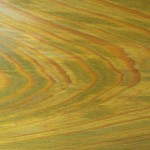Old-growth tidewater cypress is as beautiful as it is rare. Even if you can find it, it’s often just too darn expensive. New growth cypress, on the other hand, is readily available, significantly less expensive and when done right can look like a million dollars (or roughly the value of old-growth tidewater cypress).
However, when done poorly, new-growth cypress can look like as bad as a fake wood bookcase from a discount super store. The goal of a proper stain is to achieve a consistent, even and mature finish to young cypress. The way we do it seems like a recipe for disaster, but it’s THE key to properly finishing young cypress.
The secret to staining new cypress, taught to me years ago by Mr. G.I. Broussard, is (drumroll): Seal the wood before you stain it!
OK, don’t feel dumb if that strikes you as backward or just plain wrong. It is backward. I’ve had painters who have been in the business for decades look at me like I was absolutely crazy when I instructed them on how to do this. It goes against all logic.
But, here’s why it works – because young cypress has such a loose grain and so much soft wood, you can’t possibly get a consistent appearance by staining it in its natural state. The older hard wood in it will stain lighter and more brown or red in appearance. The soft wood will absorb more stain and thus achieve a darker and more green appearance.
The bottom line: If you stain before you seal, you’ll be left with a plank of wood that looks like it has been tie died.
Applying a sealant to the wood BEFORE staining it allows for a consistent and even surface for the stain to settle into and prevents the stain from penetrating into the soft wood. The result is a more consistent color and appearance.

An example of a poor stain job. Green streaks are not attractive
Our Top-Secret Family Recipe for Staining Young Cypress:
-
What You Need
- 1/2 Gallon Of Oil Varnish
- 1 Tbsp of Provincial Stain By Minwax
- 1-2 Tbsp of Raw Umber
- 1/2 Tbsp of Burnt Umber
- 1 Paint Stirrer
- High-Quality Horse Hair Brush
- Clear Coat (satin finish)
- Denatured Alcohol and Cotton Cloths for Cleanup
-
Steps
- Lightly sand the mill-finished cypress, just to get a relatively smooth and even surface for the sealer.
- Apply a full coat of Bulls Eye Shellac. Before applying the sealer, make sure you are ready to apply it to the entire surface. This stuff dries quickly and it has to be done in one brushing for each piece. Have denatured alcohol at the ready for any cleanup you might need.
- After the seal has fully dried, lightly sand the surface with steel wool being careful not to break the surface of the sealant – just to create smooth and consistent surface.
- Combine oil varnish with provincial stain.
- Place a tablespoon or so of raw umber on the bottom of your paint stirrer and use to mix your old and stain.
- Using a reserve pice of sealed and sanded cypress (preferably 24×8), apply the mix with a relatively dry brush to one end of the sample.
- Adjust color by adding small amounts of umber to your paint stirrer until you get the right depth. Do this slowly and in small amounts at a time. The umber will “dirty” the color of the wain and produce a beautiful sable brown appearance. If you get too much raw umber in the mix you might notice a green appearance to it. In this case, begin slowly adding burnt umber to the mix to bring out more reds and balance the green.
- The goal is to get a color that is a nice warm tone where you can see plenty of grain but not too much dark. You want to see the beauty of the wood, but in a warm sable brown tone.
- Once you are happy with your sample, proceed to the real thing. But, be careful not to go as dark as you think you should. Once the entire piece of furniture or cabinets (in particular) are stained and placed in a room they will appear much darker as a whole than the small sample.
- Finish with a clear coat of oil varnish in a satin finish.



